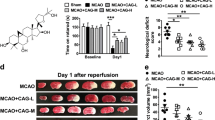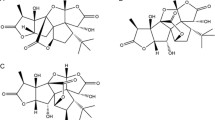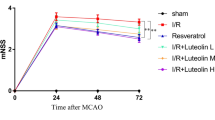Abstract
RTP801 (also known as REDD1), a stress-related protein, is induced by several environmental stresses such as ischemia and cigarette smoke. Although ischemia can dramatically up-regulate RTP801 expression in brain ischemia, up to now, the exact relation between RTP801 and neuronal death in ischemia is poorly understood. In the current study, using oxygen and glucose deprivation as an in vitro ischemic model in primary cultured cortical neurons, we found that the expression of RTP801 increased progressively with prolongation of ischemic duration, in which the expression of RTP801 is positively correlated with the release of lactate dehydrogenase (LDH) in neurons, and knockdown of RTP801 promoted neuronal survival in ischemia–reperfusion. It was further found that ginkgolide B (GB) could significantly increase cell viability and decrease LDH release, and at the same time reduce the levels of RTP801 mRNA and protein in neurons after ischemia and reperfusion. Moreover, GB-induced reduction in expression of RTP801 was blocked by application of LY294002, a specific inhibitor of phosphatidylinositol 3-kinase (PI3K). These results demonstrate that RTP801 could play a detrimental role on neurons in ischemia, and GB might protect neurons against ischemic injury by inhibiting RTP801 expression via PI3K pathway.





Similar content being viewed by others
Abbreviations
- GB:
-
Ginkgolide B
- I/R:
-
Ischemia–Reperfusion
- LDH:
-
Lactate dehydrogenase
- LY:
-
LY294002
- MTT:
-
3-(4,5-Dimethylthazol-2-yl)-2,5-diphenyltetrazolinum bromide
- OGD:
-
Oxygen and glucose deprivation
- PI3K:
-
Phosphatidylinositol 3-kinase
- REDD1:
-
Regulated in development and DNA damage responses
References
Bate C, Kempster S, Williams A (2006) Platelet-activating factor antagonists protect amyloid-beta damaged neurons from microglia-mediated death. Neuropharmacology 51(2):173–181
Brugarolas J, Lei K, Hurley RL, Manning BD, Reiling JH, Hafen E, Witters LA, Ellisen LW, Kaelin WG (2004) Regulation of mTOR function in response to hypoxia by REDD1 and the TSC1/TSC2 tumor suppressor complex. Genes Dev 18(23):2893–2904
Chung HS, Harris A, Kristinsson JK, Ciulla TA, Kagemann C, Ritch R (1999) Ginkgo biloba extract increases ocular blood flow velocity. J Ocul Pharmacol Ther 15(3):233–240
Fang D, Li Z, Zhong-ming Q, Mei WX, Ho YW, Yuan XW, Ya K (2008) Expression of bystin in reactive astrocytes induced by ischemia/reperfusion and chemical hypoxia in vitro. Biochim Biophys Acta 1782(11):658–663
Fang W, Deng Y, Li Y, Shang E, Fang F, Lv P, Bai L, Qi Y, Yan F, Mao L (2010) Blood brain barrier permeability and therapeutic time window of ginkgolide B in ischemia–reperfusion injury. Eur J Pharm Sci 39(1–3):8–14
Hao Y, Sun Y, Xu C, Jiang X, Sun H, Wu Q, Yan C, Gu S (2009) Improvement of contractile function in isolated cardiomyocytes from ischemia–reperfusion rats by ginkgolide B pretreatment. J Cardiovasc Pharmacol 54(1):3–9
Luo Y, Smith JV, Paramasivam V, Burdick A, Curry KJ, Buford JP, Khan I, Netzer WJ, Xu H, Butko P (2002) Inhibition of amyloid-β aggregation and caspase-3 activation by the Ginkgo biloba extract EGb761. Proc Natl Acad Sci 99(19):12197–12202
Ma MC, Qian H, Ghassemi F, Zhao P, Xia Y (2005) Oxygen-sensitive {delta}-opioid receptor-regulated survival and death signals: novel insights into neuronal preconditioning and protection. J Biol Chem 280(16):16208–16218
Maclennan KM, Darlington CL, Smith PF (2002) The CNS effects of Ginkgo biloba extracts and ginkgolide B. Prog Neurobiol 67(3):235–257
Malagelada C, Ryu EJ, Biswas SC, Jackson-Lewis V, Greene LA (2006) RTP801 is elevated in parkinson brain substantia nigral neurons and mediates death in cellular models of Parkinson’s disease by a mechanism involving mammalian target of rapamycin inactivation. J Neurosci 26(39):9996–10005
Malagelada C, Jin ZH, Greene LA (2008) RTP801 is induced in Parkinson’s disease and mediates neuron death by inhibiting Akt phosphorylation/activation. J Neurosci 28(53):14363–14371
Manev H, Caredda S, Grayson DR (1991) Nonselective inhibition by antisense oligonucleotides of cytosine arabinoside action. NeuroReport 2(10):589–592
Masschelein E, Van Thienen R, D’Hulst G, Hespel P, Thomis M, Deldicque L (2014) Acute environmental hypoxia induces LC3 lipidation in a genotype-dependent manner. Faseb J 28(2):1022–1034
Mejia-Garcia TA, Portugal CC, Encarnacao TG, Prado MAM, Paes-de-Carvalho R (2013) Nitric oxide regulates AKT phosphorylation and nuclear translocation in cultured retinal cells. Cell Signal 25(12):2424–2439
Ota KT, Liu RJ, Voleti B, Maldonado-Aviles JG, Duric V, Iwata M, Dutheil S, Duman C, Boikess S, Lewis DA, Stockmeier CA, DiLeone RJ, Rex C, Aghajanian GK, Duman RS (2014) REDD1 is essential for stress-induced synaptic loss and depressive behavior. Nat Med 20(5):535–539
Regazzetti C, Bost F, Le Marchand-Brustel Y, Tanti J-F, Giorgetti-Peraldi S (2010) Insulin induces REDD1 expression through hypoxia-inducible factor 1 activation in adipocytes. J Biol Chem 285(8):5157–5164
Romani-Aumedes J, Canal M, Martin-Flores N, Sun X, Perez-Fernandez V, Wewering S, Fernandez-Santiago R, Ezquerra M, Pont-Sunyer C, Lafuente A, Alberch J, Luebbert H, Tolosa E, Levy OA, Greene LA, Malagelada C (2014) Parkin loss of function contributes to RTP801 elevation and neurodegeneration in Parkinson’s disease. Cell Death Dis 5:e1364
Ruscher K, Freyer D, Karsch M, Isaev N, Megow D, Sawitzki B, Priller J, Dirnagl U, Meisel A (2002) Erythropoietin is a paracrine mediator of ischemic tolerance in the brain: evidence from an in vitro model. J Neurosci 22(23):10291–10301
Saleem S, Zhuang H, Biswal S, Christen Y, Doré S (2008) Ginkgo biloba extract neuroprotective action is dependent on heme oxygenase 1 in ischemic reperfusion brain injury. Stroke 39(12):3389–3396
Schwarzer R, Tondera D, Arnold W, Giese K, Klippel A, Kaufmann J (2004) REDD1 integrates hypoxia-mediated survival signaling downstream of phosphatidylinositol 3-kinase. Oncogene 24(7):1138–1149
Shoshani T, Faerman A, Mett I, Zelin E, Tenne T, Gorodin S, Moshel Y, Elbaz S, Budanov A, Chajut A, Kalinski H, Kamer I, Rozen A, Mor O, Keshet E, Leshkowitz D, Einat P, Skaliter R, Feinstein E (2002) Identification of a novel hypoxia-inducible factor 1-responsive gene, RTP801, involved in apoptosis. Mol Cell Biol 22(7):2283–2293
Sriram S, Subramanian S, Juvvuna PK, McFarlane C, Salerno MS, Kambadur R, Sharma M (2014) Myostatin induces DNA damage in skeletal muscle of streptozotocin-induced type 1 diabetic mice. J Biol Chem 289(9):5784–5798
Stackman RW, Eckenstein F, Frei B, Kulhanek D, Nowlin J, Quinn JF (2003) Prevention of age-related spatial memory deficits in a transgenic mouse model of Alzheimer’s disease by chronic Ginkgo biloba treatment. Exp Neurol 184(1):510–520
Wu X, Qian Z, Ke Y, Du F, Zhu L (2009) Ginkgolide B preconditioning protects neurons against ischaemia-induced apoptosis. J Cell Mol Med 13(11–12):4474–4483
Wu X, Zhou C, Du F, Lu Y, Peng B, Chen L, Zhu L (2013) Ginkgolide B preconditioning on astrocytes promotes neuronal survival in ischemic injury via up-regulating erythropoietin secretion. Neurochem Int 62(2):157–164
X-m Wu, Z-m Qian, Zhu L, Du F, W-h Yung, Gong Q, Ke Y (2011) Neuroprotective effect of ligustilide against ischaemia-reperfusion injury via up-regulation of erythropoietin and down-regulation of RTP801. Br J Pharmacol 164(2):332–343
Yang CS, Matsuura K, Huang NJ, Robeson AC, Huang B, Zhang L, Kornbluth S (2014) Fatty acid synthase inhibition engages a novel caspase-2 regulatory mechanism to induce ovarian cancer cell death. Oncogene. doi:10.1038/onc.2014.271
Yoshida T, Mett I, Bhunia AK, Bowman J, Perez M, Zhang L, Gandjeva A, Zhen L, Chukwueke U, Mao T, Richter A, Brown E, Ashush H, Notkin N, Gelfand A, Thimmulappa RK, Rangasamy T, Sussan T, Cosgrove G, Mouded M, Shapiro SD, Petrache I, Biswal S, Feinstein E, Tuder RM (2010) Rtp801, a suppressor of mTOR signaling, is an essential mediator of cigarette smoke-induced pulmonary injury and emphysema. Nat Med 16(7):767–773
Acknowledgments
This work was supported by the National Natural Science Foundation of China (31171143), National Basic Research Program of China (973 Program, 2011CB510004), Priority Academic Program Development of Jiangsu Higher Education Institutions (PAPD), Doctoral Initial Foundation of Nantong University, Neural Regeneration Co-innovation Center of Jiangsu Province, Science and Technology Project of Nantong (HS2012037), and Natural Science Foundation of Jiangsu Higher Education Institutions (12KJB310008).
Conflict of interest
The authors state no conflict of interest.
Author information
Authors and Affiliations
Corresponding author
Rights and permissions
About this article
Cite this article
Wu, X., Su, J., Chen, L. et al. Ginkgolide B Protects Neurons from Ischemic Injury by Inhibiting the Expression of RTP801. Cell Mol Neurobiol 35, 943–952 (2015). https://doi.org/10.1007/s10571-015-0189-3
Received:
Accepted:
Published:
Issue Date:
DOI: https://doi.org/10.1007/s10571-015-0189-3




